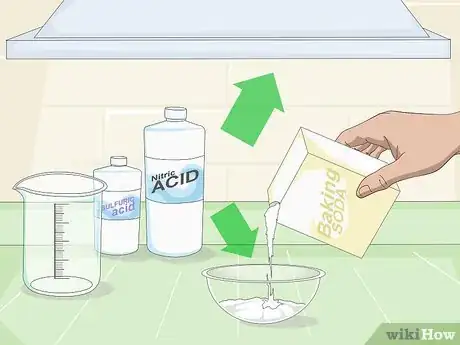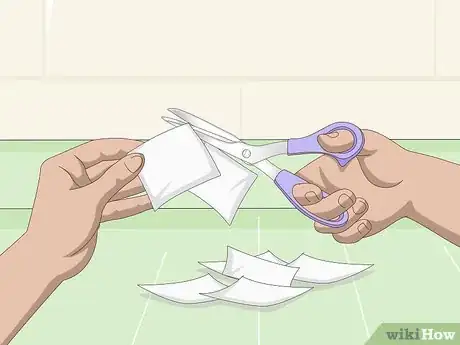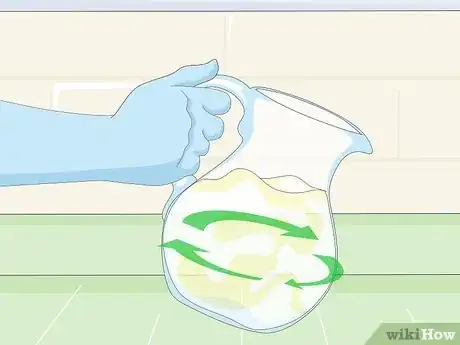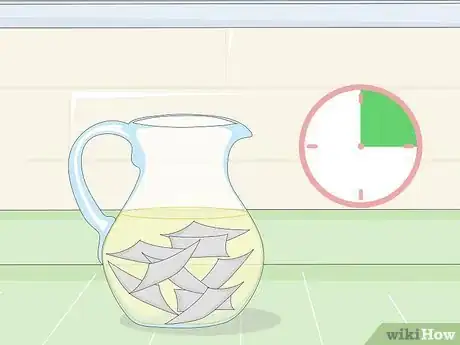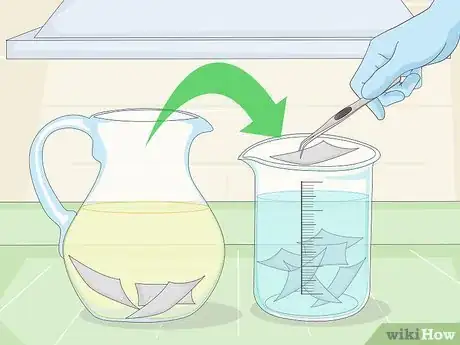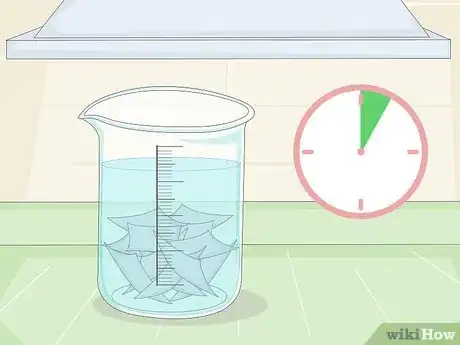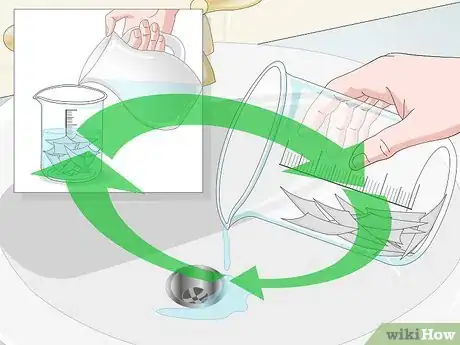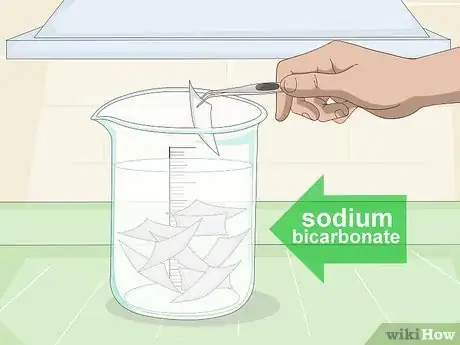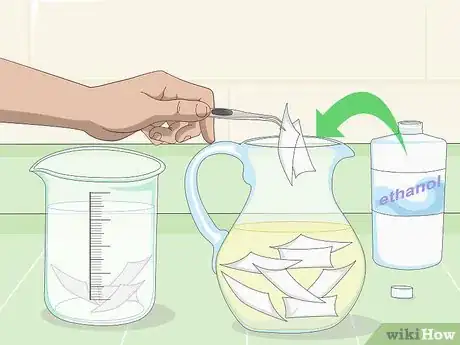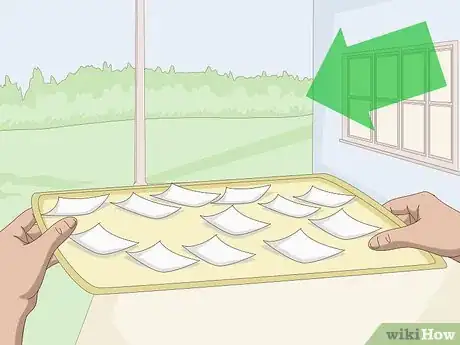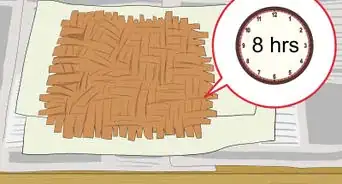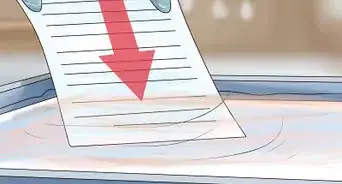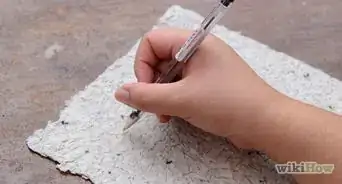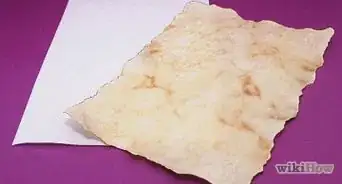This article was co-authored by wikiHow Staff. Our trained team of editors and researchers validate articles for accuracy and comprehensiveness. wikiHow's Content Management Team carefully monitors the work from our editorial staff to ensure that each article is backed by trusted research and meets our high quality standards.
This article has been viewed 218,225 times.
Learn more...
Flash paper, or nitrocellulose, is tissue treated with nitric acid so that it will burn instantly with no smoke or ash when touched to a flame. Flash paper is used for creating theatrical special effects and is also employed by magicians. It’s possible to make your own flash paper at home instead of buying expensive commercial versions. As creating flash paper requires the mixing of strong acids, you should take safety precautions and have experience working with chemicals in a laboratory setting. If you feel comfortable creating your own flash paper, you will be left with professional-grade material that you can use to astonish your family and friends!
Steps
Mixing the Acids
-
1Protect your skin and eyes. Before you begin working with acids, it’s important to wear the proper protective gear. Wear long sleeves that cover your arms as well as chemical resistant goggles, gloves, and apron. You also should have access to a fume hood that you can work under.[1]
-
2Set up your work-station. Bring all your supplies into a well-ventilated laboratory and place them next to the fume hood. Set up a bowl of baking soda in the case of an acid spill. Sodium bicarbonate neutralizes acids and makes spills less harmful and dangerous.[2]
- Make sure that the fume hood works before you begin working.
- In case of an acid spill, pour the baking soda over the spill. You will see bubbling, which means that the neutralization is taking place as gaseous C02 is released. Test the pH of the spill with pH paper. Once it’s between 6 and 9, it’s safe to wipe the spill with a sponge and wash the material down the sink.
Advertisement -
3Cut paper into squares. You can create flash paper out of tissue paper, toilet paper, or even a cotton T-shirt. Just make sure that whatever paper you use is 100% cotton. Cut out however many sheets as you want into roughly the same size as a business card.[3]
-
4Mix concentrated nitric acid and concentrated sulfuric acid in a beaker. Under the fume hood, pour concentrated nitric acid and concentrated sulfuric acid into a 1 liter (0.26 US gal) (4.2 cup) pitcher in a 5:4 ratio (5 parts concentrated nitric acid to 4 parts concentrated sulfuric acid). Make sure that you have enough liquid to eventually submerge the paper.[4]
- Stand outside the fume hood, with the beakers and acid inside the hood. Place your gloved hands inside the fume hood and do all your work at least 6 inches (15.2 cm) in from the hood opening.[5]
-
5Lightly swirl the acids together. To mix the two acids together, hold the pitcher and lightly swirl it with a slight motion of your hand. Do not shake the acid or swirl it vigorously, as this can cause the acid to splash.[6]
Soaking and Preparing the Paper
-
1Add and submerge the paper. Take one of your strips of paper and drop it into the pitcher of acid. Use a glass stirring rod to poke your paper in the water until it is completely submerged. You can do all your sheets at the same, so keep adding and submerging the sheets with the glass rod until you have added all your paper.[7]
-
2Wait for 15-20 minutes. After you have added your last sheet, wait 15-20 minutes for the paper to fully absorb the acid. By the end of the wait, tissue paper or regular paper will be off-white, while toilet paper will be slightly brown.[8]
-
3Pour water into a 1 liter (0.26 US gal) (4.2 cup) beaker. While you are waiting for the paper to soak, fill a wide 1 liter (0.26 US gal) (4.2 cup) beaker or pitcher halfway up with water. Make sure that the beaker is wide enough to fit the papers. Place the beaker of water next to the pitcher of acid.[9]
-
4Transfer the paper to a water bath. Use a pair of forceps or tongs to lift up one of the pieces of paper out of the acid. Keep the paper poised above the pitcher of acid until it stops dripping. Once the paper stops dripping, carefully drop the paper into the beaker of water. Repeat this process for each of your strips of paper, making sure that they stop dripping before you transfer them.[10]
- You are now done with the acids. Neutralize the acids by pouring baking soda into the beaker of acid, waiting until the bubbling stops. Then turn on the water and pour the neutralized acid down the drain. Run the water for a few more seconds, then turn it off.
-
5Soak the paper for about 5 minutes. Leave the pieces of paper in the water bath for about five minutes, using the glass stirrer to occasionally stir the papers. If you are using toilet paper, you should see the paper turn from brown to off-white.[11]
-
6Pour out the water and fill up the beaker. Bring the water beaker to the sink. It’s not necessary to work under the fume hood anymore, as you have finished working with the acids. Carefully pour the water out of the beaker, using the glass stirrer to push back the paper so it doesn’t escape from the beaker. After you empty out the water, turn on the sink and pour about the same amount of lukewarm water back into the beaker.[12]
- What you are essentially doing is washing the paper to get off excess acid.
-
7Repeat the washing process several times. Repeat the process of draining the water, then filling the beaker back up two or three more times. This will effectively flush the paper.[13]
-
8Place the paper on a paper towel. Take the papers out of the water bath one by one with a pair of tongs, pausing over the beaker until they finish dripping. Then place the side of the papers by side on a folded sheet of paper towel. Leave the paper on the sheet of paper towel to dry overnight, or for at least 8 hours.
- Make sure that they aren’t overlapping so that they can dry quicker.
-
9Place the paper in sodium bicarbonate. After the paper has dried, fill a 1 liter (0.26 US gal) (4.2 cup) beaker with a 1 ML solution of sodium bicarbonate. Then place each piece of paper as you did with the water bath in the sodium bicarbonate.[14]
- If you notice bubbling, take the beaker to the sink and pour out the sodium bicarbonate, holding the papers back with the glass stirrer. Then add water as you did before, adding it and emptying a few times.
- Wait for the paper to thoroughly dry, either overnight or for 8 hours.
-
10Place the paper in ethanol. Fill pitcher with enough ethanol to submerge the papers, then add the papers as you did for the sodium bicarbonate. Let them soak in the ethanol for 15-20 minutes, then take them out, waiting for them to stop dripping, and place them on a fresh folded sheet of paper towel.[15]
Lighting the Paper
-
1Bring the paper to a neutral location. When you light the paper on fire, you want to be in a safe environment with no flammable objects around. This could be a laboratory or a neutral environment like on the pavement of your driveway. Bring the papers that you dried, matches, and a flame-proof container like a baking tray or measuring cup, as well as a fire extinguisher.
-
2Hold a piece of flash paper up with forceps or tongs. First make sure that the flash paper is completely dry because the trick won’t work if it is still partially wet. When you have checked that it’s dry, use a pair of heatproof tongs or forceps to hold up the piece of flash paper over the flame-proof container.[16]
-
3Light the flash paper on fire. Light the match, then hold it up to the flash paper. You will see that the paper immediately catches fire, then starts to quickly burn down without producing any ash or residue![17]
- After you finish playing with your flash paper, put any additional pieces of paper in a safe location like a drawer or envelope, as they are extremely flammable!
Community Q&A
-
QuestionHow many chunchs of paper will this batch make before the acid bath is spent?
 Community AnswerYou can mix up however much acid you need to soak however many papers as you want, just be sure to get the 5:4 proportion of acid right.
Community AnswerYou can mix up however much acid you need to soak however many papers as you want, just be sure to get the 5:4 proportion of acid right. -
QuestionIs there a way to create a piece of flash paper that is rigid like card stock?
 Community AnswerNo, because paper prepared by this method must be as thin and light as possible.
Community AnswerNo, because paper prepared by this method must be as thin and light as possible. -
QuestionHow strong does the acid have to be?
 Community AnswerFuming or strong means the highest concentration possible. Less concentrated acids won't produce the desired result.
Community AnswerFuming or strong means the highest concentration possible. Less concentrated acids won't produce the desired result.
Warnings
- Acid spills can cause serious burns as well as damage your skin and eyes. Always wear the right protective gear and make sure that you are working under a fume hood when working with acid.⧼thumbs_response⧽
- In case of a fire, pull the pin at the top of the extinguisher, aim the nozzle at the base of the fire, squeeze the lever and sweep the extinguisher from side to side until the fire has been completely extinguished. Call 911 if the fire is out of control.⧼thumbs_response⧽
- Do not attempt to make flash paper if you don’t have access to a laboratory and are not an experienced chemist.⧼thumbs_response⧽
Things You’ll Need
- 100% cotton toilet paper, tissue paper or cloth
- Concentrated nitric acid
- Concentrated sulfuric acid
- Baking soda
- Sodium bicarbonate
- Paper towels
- Tongs or forceps
- 4 scientific beakers
- Heatproof tray
- Glass stirring rod
- Fire extinguisher
- Acid proof gloves
- Acid proof apron
- Acid proof goggles
References
- ↑ https://www.flinnsci.com/globalassets/flinn-scientific/all-free-pdfs/dc91356.pdf
- ↑ https://www.tamut.edu/About/Administration/Environmental-Health-and-Safety/Information%20Folder/Chemical%20disposal.pdf
- ↑ https://www.youtube.com/watch?v=Ir9vU0N73l4
- ↑ https://www.flinnsci.com/globalassets/flinn-scientific/all-free-pdfs/dc91356.pdf
- ↑ http://smah.uow.edu.au/content/groups/public/@web/@sci/@chem/documents/doc/uow059174.pdf
- ↑ https://www.youtube.com/watch?v=Ir9vU0N73l4
- ↑ https://www.flinnsci.com/globalassets/flinn-scientific/all-free-pdfs/dc91356.pdf
- ↑ https://www.flinnsci.com/globalassets/flinn-scientific/all-free-pdfs/dc91356.pdf
- ↑ https://www.flinnsci.com/globalassets/flinn-scientific/all-free-pdfs/dc91356.pdf
- ↑ https://www.flinnsci.com/globalassets/flinn-scientific/all-free-pdfs/dc91356.pdf
- ↑ https://www.flinnsci.com/globalassets/flinn-scientific/all-free-pdfs/dc91356.pdf
- ↑ https://www.flinnsci.com/globalassets/flinn-scientific/all-free-pdfs/dc91356.pdf
- ↑ https://www.flinnsci.com/globalassets/flinn-scientific/all-free-pdfs/dc91356.pdf
- ↑ https://www.flinnsci.com/globalassets/flinn-scientific/all-free-pdfs/dc91356.pdf
- ↑ https://www.flinnsci.com/globalassets/flinn-scientific/all-free-pdfs/dc91356.pdf
- ↑ https://www.flinnsci.com/globalassets/flinn-scientific/all-free-pdfs/dc91356.pdf
- ↑ https://www.flinnsci.com/globalassets/flinn-scientific/all-free-pdfs/dc91356.pdf
About This Article
Flash paper is tissue or toilet paper treated with nitric acid so that it burns instantly without smoke or ash. The preparation will take a little while and should only be done in a laboratory by an experienced chemist. You’ll need tissues or toilet paper that are 100 percent cotton, concentrated nitric acid, concentrated sulfuric acid, baking soda, sodium bicarbonate, paper towels, basic lab equipment, and safety gear. It’s important to wear safety goggles and protective gear and work in a well ventilated lab whenever working with acid. You should also have a bowl of baking soda ready in case you spill any acid. To prepare your flash paper, you’ll need to soak it in a nitric and sulfuric acid mixture, then water, then sodium bicarbonate, and finally ethanol. Once the papers have dried, you’ll want to take them to an open environment with no flammable objects around. Hold each piece of paper with tongs and light it with a match or lighter to see it burst into flames. For more tips, including how long to soak your paper in each substance, read on!

